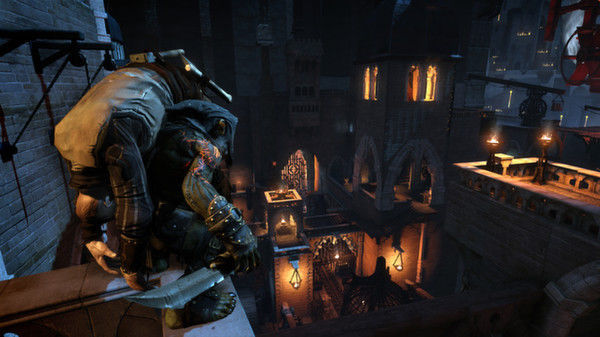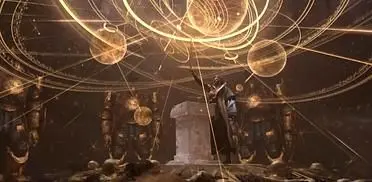A prequel spin-off to Cyanide Studio’s 2012 action RPG Of Orcs and Men, Styx: Master of Shadows takes place in a relatively unique world where Goblins and Orcs aren’t all necessarily villains and where humans and elves can be just as vile. To be honest, the story is largely throw away fluff but still the gameplay in Styx: Master of Shadows should prove familiar to fans of Splinter Cell, Assassin's Creed and other entries in the stealth adventure genre.
 |
| Hiding bodies is pretty much essential to the whole not-being-detected shtick |
Played from third-person, each of Styx's missions play out more like stealth-themed playgrounds than bespoke locations with atmospheres and nuances of their own. In each mission, Styx is usually required to steal an item, reach an area or perform an assassination and all three can be incorporated into both primary and secondary objectives.
Like just about any other entry in the genre, a robust focus is placed on avoiding detection and perhaps most like Ubisoft's Splinter Cell franchise, a rather large premium is set on using the darkness to your advantage to either skulk past foes or murder them clandestinely. The similarities to the French publisher's Tom Clancy series don't end there either, as Styx has a visual indicator on his person which helpfully informs the player as to how noticeable they are to potential foes. Sam Fisher has those three iconic green lights, Styx has a fiery tattoo on his shoulder that illuminates the more consumed in darkness he is. Same deal, really.
Like any stealth title that deals with darkness as its currency for player survival, in Styx: Master of Shadows, it can be both found or created. While torches can be extinguished either up close or from afar by tossing lumps of sand to smother their blaze, Styx's AI foes are also smart enough to see the lights go out around them and will make an attempt to rekindle their fire.
Equally, like other games in the stealth genre which enables the player to murder things, hiding bodies decently is pretty much an essential part of the job. Leave a mouldering corpse out in plain view for everyone to see and the guards will come running; but between the repeated dialogue and what seems to be the collective memory capacity of a goldfish, the illusion that you're some sort of apex predator intruder is lost on these guards pretty quickly as they return to their meandering patrols. Luckily though, there are a number of handily placed chests and closets dotted around each map which allow Styx to hide his dirty work away from prying eyes.
Sound is a big part of Styx's stealth gameplay also. A leap onto carpet or rug instead of a rock floor will create very little noise, whereas kills can be divided into regular and muffled assassinations. The former, while swifter in execution, creates noise that could attract unwanted attention, the latter on the other hand is silent but takes much longer to pull off. In truth, it's a pretty decent system and it certainly teaches the player patience over recklessness, as the need to make time for quieter murders soon takes precedence over fast and loud fatal stabbings.
Elsewhere, Styx can peer through keyholes to see what lies beyond in a room, pick locks, use invisibility magic, create clones to distract, hide under tables and generally do everything he can to avoid detection. As is usually the case with stealth titles, once you've been detected (and assuming that if that happens it isn't an instant-fail condition) you usually get a chance to either flee or fight your foe. In Styx: Master of Shadows, players will want to avoid detection not least because it might result in game-ending situations, but because what follows is a motley bunch of very poorly conceived gameplay mechanics that tarnish the decent, if workmanlike stealth mechanics seen everywhere else.
 |
| Styx’s tattoos aren’t just for show; they provide an indication of how visible he is |
Should Styx be forced into confrontation with an enemy, combat plays out almost in a QTE-style fashion as the player is required to parry the strikes of their opponent at the right time before delivering the fatal blow at the behest of the game's UI. It's a sloppy system that aside from being light years away from the elegant, yet simplistic combat of the Assassin's Creed games, presents a much larger problem. You see, when Styx is in one these 'duels' he is unable to focus on more than one attacker at a time, ensuring that plenty of unanswered damage is taken from other parties before the fight is concluded.
The problem is exacerbated by the fact that like the protagonist in most other stealth games, poor old Styx is seemingly made of glass, so upon detection your options are run (assuming the game doesn't 'stick' you into duel mode too quickly) or fight in the aforementioned shoddy QTE mini-game all the while praying that enemies in your local vicinity have their ear plugs in.
It's really not good fun at all and is a reliable source of constant frustration.
Another problem is Styx's expanded skill set. The completion of each mission in addition to secondary and tertiary objectives, such as not killing anyone or finishing the affair in a timely fashion, earns the players skill points which can be piled into a number of skill-trees RPG style. Here, players can unlock skills that allow them to pounce on enemy, kill around corners, use their clones for inventive kills or expand their inventory to name just a few. Furthermore, previous missions can be replayed to further top up those SP reserves should the player feel like it, but doing so, feels like more of a chore than something that most players would consciously enjoy.
The real issue here though, is that in the case of the assassination skills such as the pouncing and around the corner kills, they should really be in the game already. Players already have an expectation of what their character should be able to do in these games and locking certain abilities and skills behind a progression wall when we've been enjoying them for years in other games, feels restrictive at best and downright cheeky at worst.
Technically speaking, the game is not unpleasant on the eyes by any stretch, but it definitely has the strong whiff of a game with a limited budget. In-game cut scenes use real-time assets but are recorded as poorly-encoded video, while even on maximum settings, textures don't hold up to close scrutiny; appearing both blurry and lacking in crucial detail. Furthermore, the game has more than its fair share of graphical glitches too as limbs pop through walls and corpses routinely spasm on the floor when placed next to each other.
It's not all dreary news on the visual front however, as Styx's aesthetics fare much better in the open air; deftly illustrating the exterior of the great expansive fortresses and towers that he infiltrates rather than the dingy tunnels and bland interiors that usually follow not long after.
 |
| The levels are large indeed; providing multiple paths through each mission |
Styx is a likeable protagonist and is quite possibly the best videogame goblin of all time, but his humorous nature and sailor-like vernacular isn't enough to lift his game beyond the abyss of mediocrity it languishes in. Very much stealth by the numbers, Styx's levels feel more like joyless assault courses built to test the skills honed in other games than truly entertaining experiences in their own right.
Spewing poison into a guard’s food bowl before watching them eat it and keel over from the toxins. Food hygiene 101 this isn’t.
STYX: MASTER OF SHADOWS VERDICT
As such, it’s difficult to recommend Styx: Master of Shadows to all but the most hardcore shadow skulker when the many other games that have come before it have all done the whole stealth thing that much better.
TOP GAME MOMENT
Spewing poison into a guard’s food bowl before watching them eat it and keel over from the toxins. Food hygiene 101 this isn’t.




